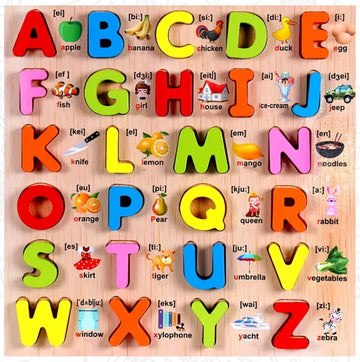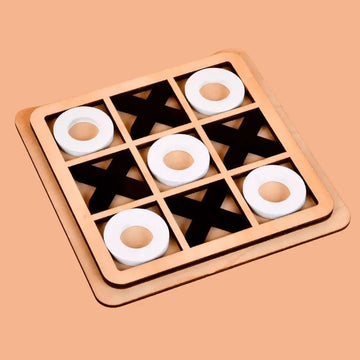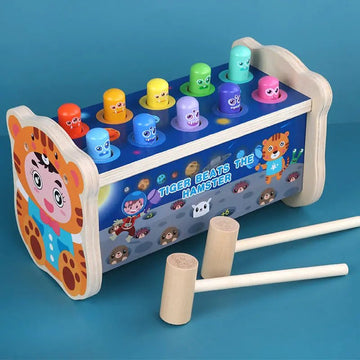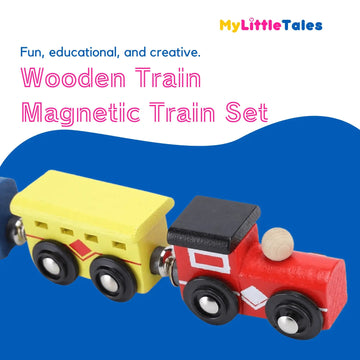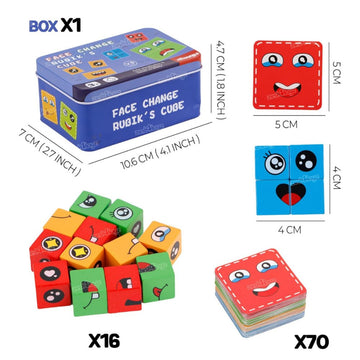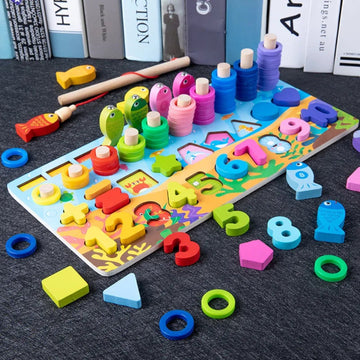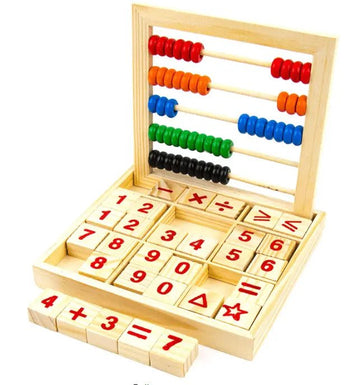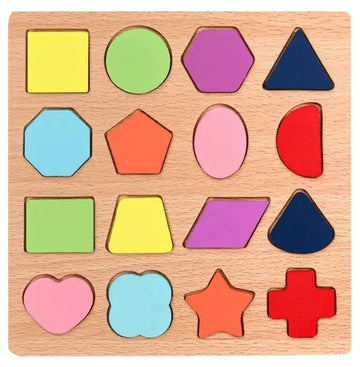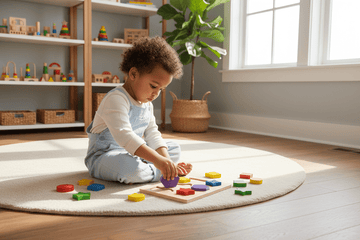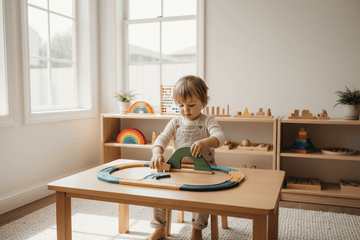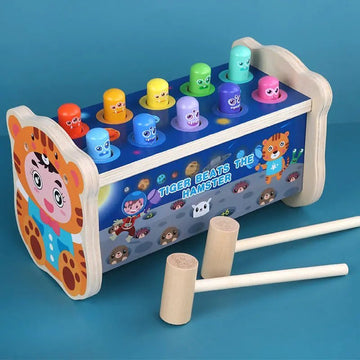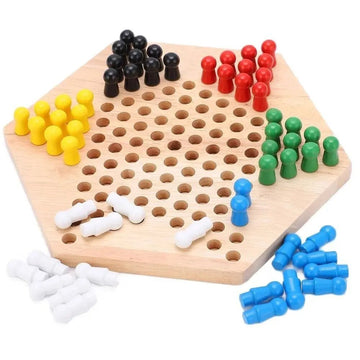The Timeless Value of Wooden Shape Puzzles
In a world overflowing with plastic toys and digital distractions, wooden educational puzzles stand as beacons of timeless learning. These carefully crafted tools offer children far more than simple entertainment; they provide a foundation for cognitive growth, sensory development, and problem-solving skills that last a lifetime. Unlike their mass-produced counterparts, quality wooden puzzles engage multiple senses simultaneously, creating deeper neural connections as little hands manipulate natural materials.
Parents and educators alike have rediscovered the profound impact these classic learning tools have on early childhood development. The smooth texture of wooden pieces, the satisfying click as shapes find their proper place, and the visual accomplishment of completing a puzzle all contribute to a rich learning experience that plastic alternatives simply cannot replicate. Let's explore why wooden educational puzzles remain essential components in nurturing well-rounded, capable young minds.
Cognitive Development Through Tactile Exploration
The journey of cognitive development begins with sensory experiences, and wooden educational puzzles provide the perfect medium for this exploration. When children handle wooden puzzle pieces, they're not just playing; they're processing complex information through touch, sight, and spatial awareness. The weight, texture, and natural warmth of wood create a multisensory experience that plastic toys cannot match.
Research consistently shows that tactile learning experiences form stronger neural pathways in developing brains. As children manipulate wooden shapes, they're building crucial connections between physical experiences and abstract concepts. This hands-on learning approach helps children internalize concepts of size, shape, and spatial relationships more effectively than passive learning methods.
How Wooden Puzzles Enhance Problem-Solving Skills
Problem-solving abilities develop remarkably through puzzle play, particularly with wooden educational puzzles that offer just the right level of challenge. When a child encounters a wooden shape puzzle, they embark on a cognitive journey that involves several critical thinking processes:
- Analysis and assessment: Children must first examine both the puzzle board and available pieces
- Trial and error: The process of attempting different combinations builds resilience and persistence
- Pattern recognition: Identifying similarities and differences between shapes strengthens visual discrimination
- Spatial reasoning: Understanding how pieces relate to one another in physical space develops mathematical thinking
- Sequential thinking: Learning to approach complex problems in logical steps creates foundational planning skills
The wooden geometric shape building blocks puzzle exemplifies this perfectly, challenging children to match shapes while simultaneously developing color recognition and categorization skills. When children successfully complete such puzzles, they experience a genuine sense of accomplishment that builds confidence and motivates further learning.
Unlike digital puzzles that offer instant gratification and automated hints, wooden puzzles require sustained attention and genuine problem-solving. This builds greater cognitive resilience and a deeper sense of achievement when solutions are discovered independently.
The Montessori Advantage of Natural Materials
The Montessori approach to education has long championed the use of natural materials in children's learning environments. This philosophy recognizes that children absorb knowledge through their senses and interaction with their physical environment. Wooden educational puzzles align perfectly with these principles, offering authentic sensory feedback that synthetic materials simply cannot provide.
Maria Montessori herself observed that children have an innate sensitivity to quality and authenticity in their learning materials. This "absorbent mind," as she called it, naturally gravitates toward and benefits from natural elements like wood. The grain patterns, subtle weight variations, and organic warmth of wooden puzzles speak to this innate preference.
Why Premium Wood Creates Superior Learning Experiences
The quality of materials directly impacts the quality of learning. Premium wooden puzzles offer several distinct advantages over plastic alternatives:
- Sensory richness: Natural wood grain provides subtle tactile feedback that enhances sensory processing
- Temperature responsiveness: Wood warms to the touch, creating a more inviting and comfortable play experience
- Weight and substance: The natural heft of wooden pieces provides important feedback about physical properties
- Durability and longevity: Quality wooden puzzles often become family heirlooms, passed between generations
- Environmental consciousness: Sustainable wooden toys teach children to value natural resources
The craftsmanship evident in well-made wooden puzzles also communicates an important message to children: quality matters. When we provide children with carefully crafted learning materials, we demonstrate that their education deserves investment and attention to detail.
Studies from the Journal of Environmental Psychology suggest that regular contact with natural materials like wood can reduce stress and improve concentration in children. This makes wooden educational puzzles not just tools for cognitive development, but also for emotional regulation and focused attention.
Developmental Milestones Supported by Shape Recognition
Shape recognition represents a fundamental cognitive milestone that wooden puzzles are uniquely positioned to support. As children learn to distinguish between circles, squares, triangles, and more complex shapes, they're building the visual discrimination skills that will later support reading, writing, and mathematical understanding.
When a child successfully matches a wooden shape to its corresponding space, they're developing several critical skills simultaneously:
- Visual discrimination: Distinguishing between similar shapes strengthens the same neural pathways used for letter recognition
- Hand-eye coordination: Precisely placing pieces develops fine motor control needed for writing
- Categorization: Grouping similar shapes builds classification skills essential for mathematical thinking
- Spatial awareness: Understanding how objects relate to one another in space supports geometric reasoning
These foundational skills form the building blocks for academic success across multiple disciplines. Research from developmental psychologists indicates that strong shape recognition in early childhood correlates with stronger mathematical performance in later school years.
Age-Appropriate Wooden Puzzles for Each Growth Stage
Selecting the right wooden educational puzzles for your child's developmental stage maximizes their learning potential while maintaining an appropriate level of challenge:
6-12 months:
- Simple wooden puzzles with large, easy-to-grasp knobs
- Basic shapes with minimal pieces
- Focus on sensory exploration and cause-effect relationships
12-24 months:
- Chunky wooden shape sorters with 3-5 basic shapes
- Puzzles that incorporate primary colors for color recognition
- Pieces that can be stacked as well as sorted
2-3 years:
- Wooden puzzles with 5-10 pieces featuring familiar objects
- Simple jigsaw-style connections between pieces
- Introduction to more complex shapes beyond the basics
3-5 years:
- Multi-level wooden puzzles that teach sequential thinking
- Puzzles incorporating letters, numbers, or patterns
- Shape puzzles that can be arranged in multiple configurations
The wooden geometric shape building blocks puzzle set grows with your child, offering different challenges as their cognitive abilities develop. This adaptability makes quality wooden puzzles excellent investments in your child's developmental journey.
Fine Motor Development and Hand Strength
The physical manipulation of wooden puzzle pieces contributes significantly to the development of fine motor skills and hand strength. These physical abilities are crucial prerequisites for writing, drawing, and self-care tasks that children will need throughout life.
When children grasp, manipulate, and place wooden puzzle pieces, they're exercising the small muscles in their hands and fingers. This precise movement requires coordination between the brain and muscles, strengthening neural pathways that control movement. The resistance and weight of wooden pieces provide just enough challenge to build strength without frustration.
Occupational therapists frequently recommend wooden puzzles specifically because they require a more deliberate grip than lightweight plastic toys. This deliberate manipulation helps children develop:
- Pincer grip: Essential for holding pencils and other writing tools
- Wrist stability: Needed for controlled drawing and writing movements
- Bilateral coordination: Using both hands together in complementary ways
- Finger isolation: The ability to move individual fingers independently
These physical skills develop alongside cognitive abilities, creating a comprehensive learning experience that addresses multiple developmental domains simultaneously.
Social and Emotional Benefits of Puzzle Play
Beyond cognitive and physical development, wooden educational puzzles offer significant social and emotional benefits. When children work on puzzles, either independently or collaboratively, they develop crucial life skills:
- Persistence: Learning to work through challenges without giving up
- Emotional regulation: Managing frustration when pieces don't immediately fit
- Pride and self-confidence: Experiencing genuine accomplishment upon completion
- Cooperation: Working together to solve more complex puzzles
- Communication: Discussing strategies and describing spatial relationships
When parents or educators engage in puzzle play alongside children, these moments become opportunities for connection and language development. Conversations about shapes, colors, strategies, and progress enrich vocabulary while strengthening relationships.
The natural pace of wooden puzzle play also encourages mindfulness and present-moment awareness. In our fast-paced world, these moments of focused attention represent valuable opportunities for children to develop concentration skills that will serve them throughout life.
The Sustainable Choice for Conscious Parents
Choosing wooden educational puzzles represents more than just a developmental decision; it's also an environmental one. Quality wooden puzzles, especially those made from sustainable sources, have a significantly lower environmental impact than their plastic counterparts.
When children interact with beautifully crafted wooden toys, they develop an early appreciation for natural materials and craftsmanship. This subtle introduction to sustainability can shape their values and consumer choices later in life. Additionally, wooden puzzles that stand the test of time reduce waste by eliminating the cycle of disposable toys that quickly break or lose appeal.
Many premium wooden puzzle manufacturers prioritize sustainable forestry practices, non-toxic finishes, and ethical production methods. By selecting these products, parents demonstrate their commitment to both their child's development and the planet their child will inherit.
Bringing It All Together: The Complete Developmental Picture
The humble wooden shape puzzle represents far more than a simple toy; it's a comprehensive developmental tool that addresses multiple aspects of childhood growth simultaneously. From cognitive and physical development to social, emotional, and environmental awareness, these timeless learning materials offer exceptional value for discerning parents and educators.
The tactile richness of wooden educational puzzles creates learning experiences that engage multiple senses, forming stronger neural connections than screen-based alternatives. The natural resistance and weight of wooden pieces build important physical skills while providing authentic sensory feedback. And the open-ended nature of quality puzzles allows children to revisit them at different developmental stages, discovering new challenges and possibilities.
By investing in premium wooden puzzles like the wooden geometric shape building blocks puzzle set, parents provide their children with learning tools that will grow with them, supporting development across multiple domains while standing the test of time. In a world of disposable distractions, these enduring educational treasures represent an investment not just in present play, but in future potential.

